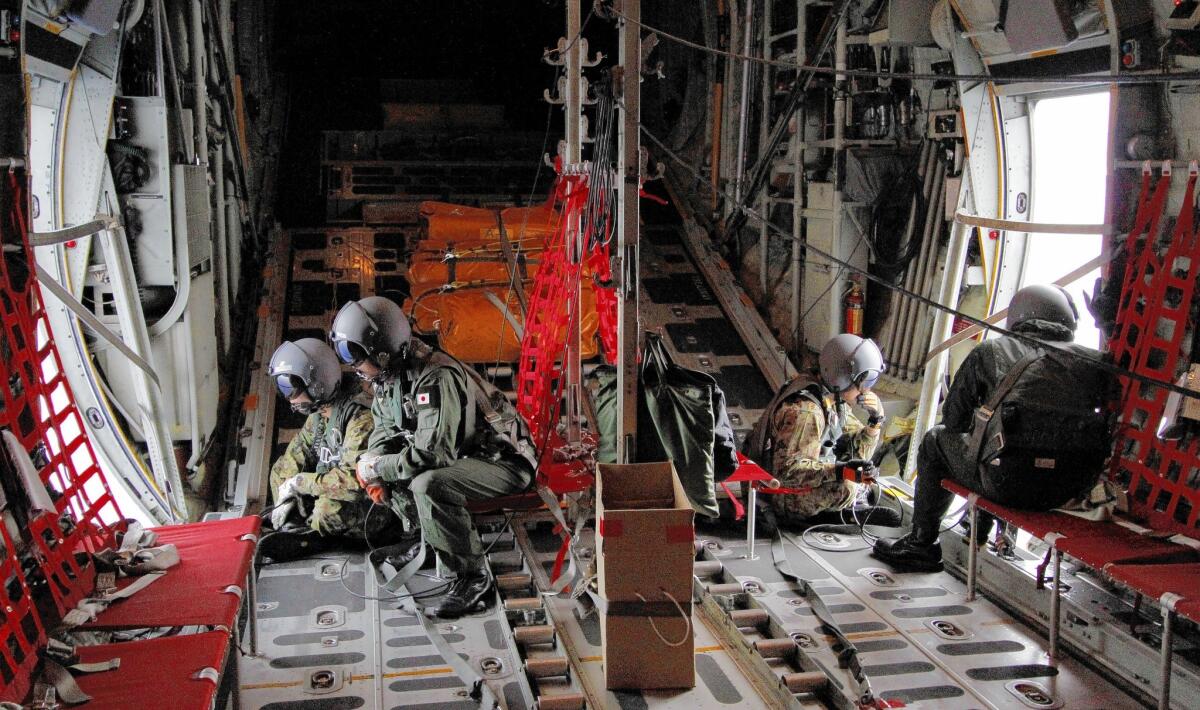Hunt for missing Malaysia Airlines flight intensifies

- Share via
KUALA LUMPUR, Malaysia –- The hunt for debris from Malaysia Airlines Flight 370 intensified Saturday as Australian officials deployed additional aircraft and spotters to comb a wider expanse of waters in a remote and treacherous part of the south Indian Ocean.
The Australian Maritime Safety Authority, which is leading a multinational search-and-rescue operation off the coast of western Australia, said it was dispatching six aircraft, including two commercial jets with 10 air observers, to cover an area of about 13,900 square miles.
On Friday, five aircraft crisscrossed an area of about 8,900 square miles but found no trace of objects that could be related to the plane, a Boeing 777 that went missing after departing Kuala Lumpur en route to Beijing on March 8.
PHOTOS: Malaysia Airlines plane missing
The first aircraft, an Australian air force P-3 Orion, left for the search area at 9 a.m. Saturday followed shortly by two long-range commercial jets. Two merchant ships are also in the search area, and an Australian naval ship capable of picking up wreckage was to arrive Saturday afternoon.
The scouring of this part of the ocean began Thursday after Australian officials reported that a satellite had picked up images of objects that could have come from the jetliner.
The search has been complicated not only by the area’s frequently wild weather, but uncertainty over where debris could have been carried by ocean currents. Australian officials are trying to track water movements with four marker buoys that were dropped in the search area.
Airplanes, ships and helicopters from China, Japan and other countries also are heading to the area. But the lack of success provided a reality check after the satellite images raised hope of solving the mystery of the missing flight.
“This is going to be a long haul,” Malaysia’s acting transport minister, Hishammuddin Hussein, said at a news conference. He said he planned to ask U.S. Defense Secretary Chuck Hagel for additional help and equipment, including deep-sea salvage vehicles.
The search from the air has included four Australian air force P-3 Orions, one U.S. Navy P-8 Poseidon and a New Zealand P-3 Orion.
The planes are outfitted with advanced radar and electronic signal sensors to identify, find and track surface targets. They can drop sonar systems that send back signals indicating what’s below the water’s surface.
One type of aircraft not in use are is the drone. Drones helped measure radiation during Japan’s nuclear reactor meltdown, penetrated the eyes of hurricanes to gather data and helped firefighters see hot spots during wildfires. But military officials say their high-tech cameras and sensors are better suited for missions over land.
Because of the long distance to fly to that section of the ocean, aircraft have only about two hours of search time before returning to refuel.
There was some speculation that the objects spotted Sunday by a satellite could have submerged. Australian officials said it wasn’t until Thursday that the images were reported to authorities because of a large volume of film and time needed for analysis.
Australian Prime Minister Tony Abbott on Friday defended his decision to announce the satellite imagery. He said he had a duty to pass on the information to families of the missing passengers. At the same time, Abbott reiterated that the two objects detected on the film, one of them about 79 feet long, may have nothing to do with the missing jetliner.
“It could just be a container that has fallen off a ship, we just don’t know,” he said.
Malaysian officials said Friday that they had no update on data deleted from the flight simulator that Flight 370 pilot Zaharie Ahmad Shah built at his home. Asked about reports that Zaharie made a phone call before takeoff, Malaysia Airlines Chief Executive Ahmad Jauhari Yahya said Friday without elaborating that the information was being passed on to authorities.
Times staff writer W.J. Hennigan in Los Angeles contributed to this report.
More to Read
Sign up for Essential California
The most important California stories and recommendations in your inbox every morning.
You may occasionally receive promotional content from the Los Angeles Times.














